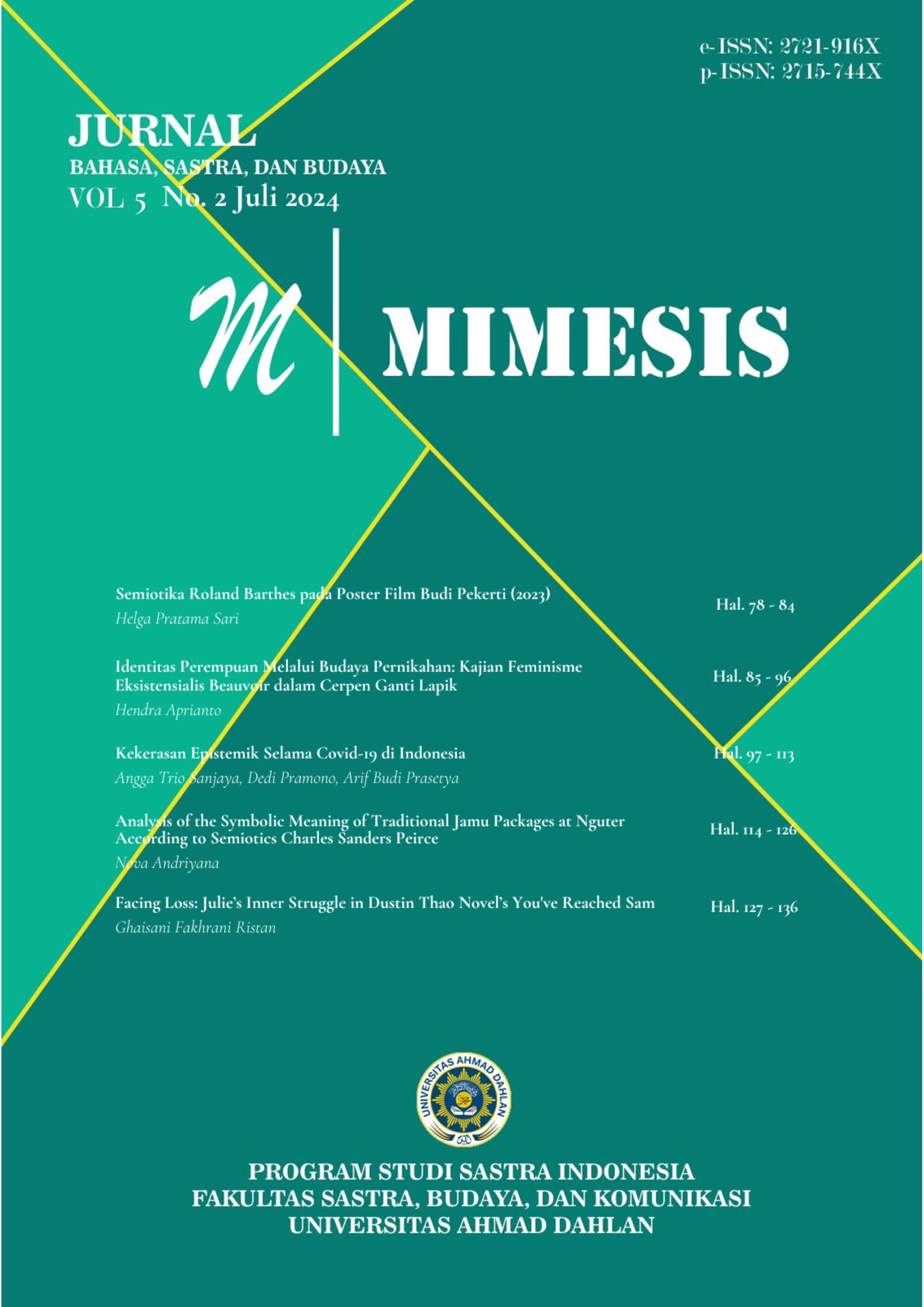Analysis of the Symbolic Meaning of Traditional Jamu Packages at Nguter According to Semiotics Charles Sanders Peirce
DOI:
https://doi.org/10.12928/mms.v5i2.11208Keywords:
Jamu, Packaging, Semiotics, Visual MeaningAbstract
Jamu made from processed herbal plants has become an alternative treatment option for the Javanese people to prevent and alleviate disease symptoms. Attractive packaging of herbal products can create a positive visual impression, encouraging consumers to try them. This study examines eight jamu packages incorporating elements of Javanese culture, interpreting the meanings they convey. Examples of the analyzed names include Sri Putih, Sari Asih, Sari Asmara, Arum Bulan, Candra Dewi, Sepet Wangi, Super Semar Turmeric Powder, and Candik Ayu. The article also investigates the context behind the use of icons, symbols, and indexes on the packaging. The names of the jamu packages are derived from the Bausastra dictionary, considering the basic meanings used in naming these products. Ultimately, the study concludes that jamu packaging carries symbolic meanings based on Charles Sanders Peirce’s semiotic method, which suggests to potential consumers the benefits of the products. These symbolic meanings can influence consumers through the icons, symbols, and indices on the packaging.
References
Cherry, K. (2019). Color Psychology: Does It Affect How You Feel? How Colors Impact Moods, Feelings, and Behaviors, 1–7. Verywellmind.Com. https://www.verywellmind.com/color-psychology-2795824
Erlyana, Y. (2022). Analisis Semiotika Ornamen Pada Kemasan Produk Lokal Minuman Herbavera. Demandia, 7(1), 45. https://doi.org/10.25124/demandia.v7i1.3939
Hamidah, M. (2023). Asal Usul Jamu Sudah Ada sejak Kerajaan Mataram. Inews.Id. https://www.inews.id/travel/kuliner/asal-usul-jamu-sudah-ada-sejak-kerajaan-mataram-ternyata-belum-banyak-yang-tahu
Indonesia.go.id. (2019). Sejarah dan Perkembangan Jamu, Minuman Tradisonal Indonesia. Indonesia.Go.Id. https://indonesia.go.id/ragam/komoditas/sosial/sejarah-dan-perkembangan-jamu-minuman-tradisonal-indonesia.
Irsyad, M. N., Jumari, J., & Murningsih, M. (2013). Studi Etnobotani Masyarakat Desa Sukolilo Kawasan Pegunungan Kendeng Pati Jawa Tengah. Bioma : Berkala Ilmiah Biologi, 15(1), 27. https://doi.org/10.14710/bioma.15.1.27-34
Jalur Rempah. (2021). Jamu, Minuman Tradisional Penuh Sejarah. Jalur Rempah Kemdikbud. https://jalurrempah.kemdikbud.go.id/foto/jamu-minuman-tradisional-penuh-sejarah
Javanologi. (2021). Jejak Jamu Dalam Goresan Sejarah. Javanologi UNS. https://javanologi.uns.ac.id/2021/09/01/jejak-jamu-dalam-goresan-sejarah/
Kunmei, L., Indira, D., Soeria Soemantri, Y., & Lupi Ardiati, R. (2022). Analisis Semiotika Pierce: Perbandingan Poster Iklan Sampo Di Tiongkok Dan Indonesia. Mimesis, 3(1), 58–74. https://doi.org/10.12928/mms.v3i1.5560
Kurt, S., & Osueke, K. K. (2014). The Effects of Color on the Moods of College Students. https://doi.org/10.1177/2158244014525423
Lestari, Widi, M. (2023). Sejarah Jamu di Indonesia. Fimela. https://www.fimela.com/lifestyle/read/3830417/sejarah-jamu-di-indonesia
Martinet, J. (2010). Semiologi: Kajian Teori Tanda Sausurian. Jalasutra Yogyakarta.
Rusdy, S. (2015). Semiotika dan Filsafat Wayang. Yayasan Kertagama.
Rusyida, H. R., & Hanum, N. (2018). Jamu Sebagai Bagian dari Kearifan Lokal Desa Nguter. CV. Resi Terbit.
Stanford. (2010). Peirce’s Theory of Signs Stanford Encyclopedia of Philosophy. Stanford Encyclopedia of Philosophy, 1–17. https://plato.stanford.edu/entries/peirce-semiotics/ papers3://publication/uuid/24AE515A-E3E6-473D-91D4-AED2D03E173D
Downloads
Published
Issue
Section
License
Copyright (c) 2024 Nova Andriyana

This work is licensed under a Creative Commons Attribution-ShareAlike 4.0 International License.
License and Copyright Agreement
In submitting the manuscript to the journal, the authors certify that:
- They are authorized by their co-authors to enter into these arrangements.
- The work described has not been formally published before, except in the form of an abstract or as part of a published lecture, review, thesis, or overlay journal.
- That it is not under consideration for publication elsewhere,
- That its publication has been approved by all the author(s) and by the responsible authorities tacitly or explicitly of the institutes where the work has been carried out.
- They secure the right to reproduce any material that has already been published or copyrighted elsewhere.
- They agree to the following license and copyright agreement.
Copyright
Authors who publish with Mimesis agree to the following terms:
- Authors retain copyright and grant the journal right of first publication with the work simultaneously licensed under a Creative Commons Attribution License (CC BY-SA 4.0) that allows others to share the work with an acknowledgment of the work's authorship and initial publication in this journal.
- Authors are able to enter into separate, additional contractual arrangements for the non-exclusive distribution of the journal's published version of the work (e.g., post it to an institutional repository or publish it in a book), with an acknowledgment of its initial publication in this journal.
- Authors are permitted and encouraged to post their work online (e.g., in institutional repositories or on their website) prior to and during the submission process, as it can lead to productive exchanges, as well as earlier and greater citation of published work.












